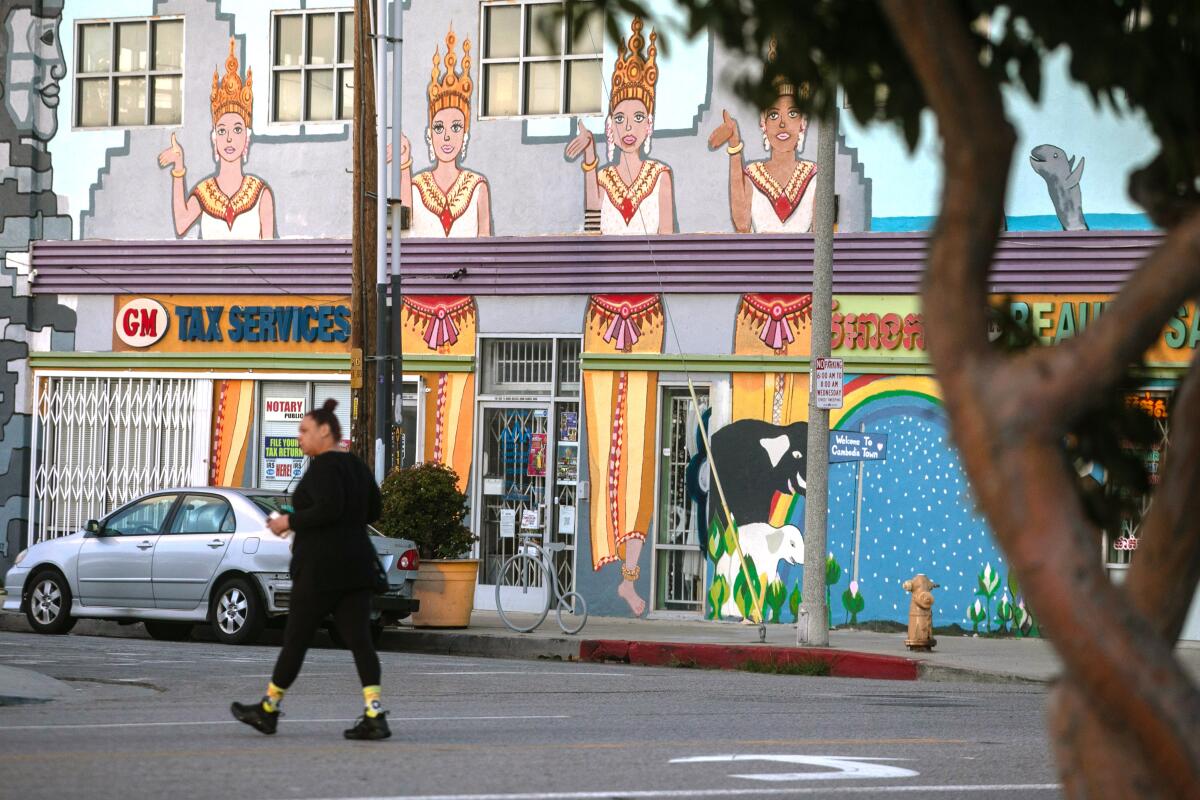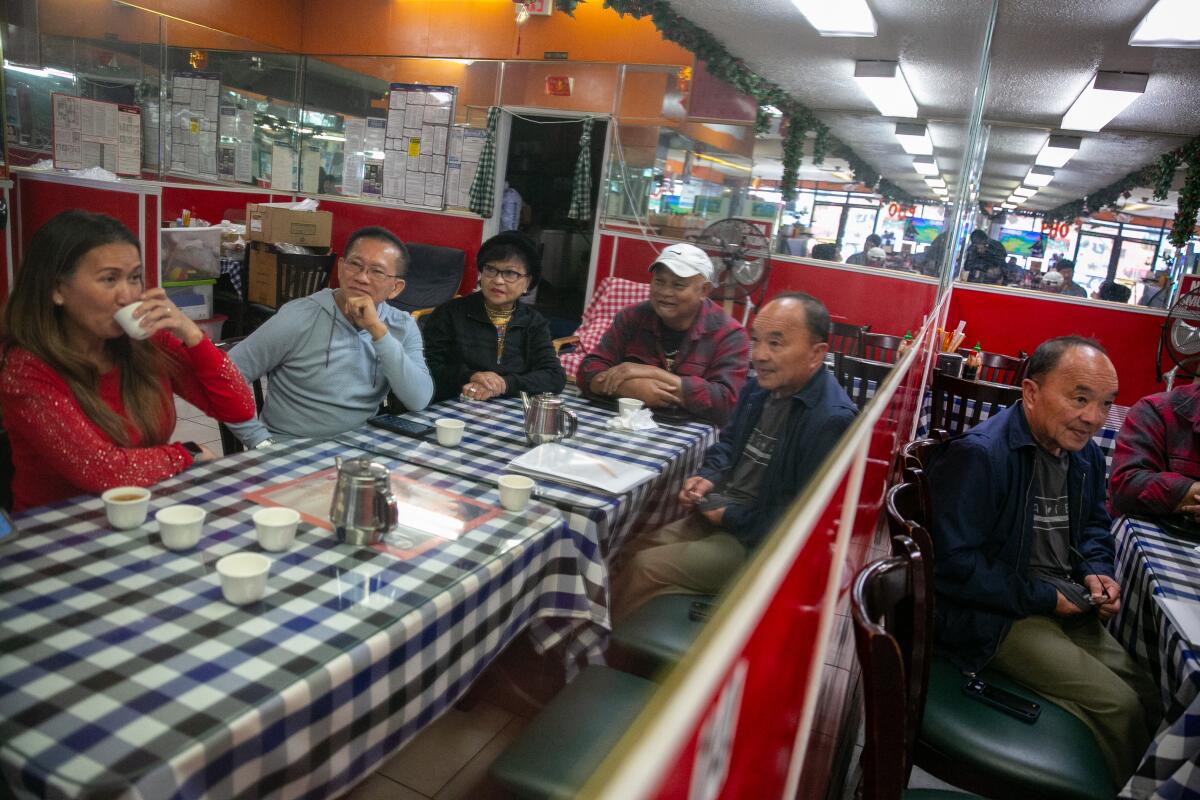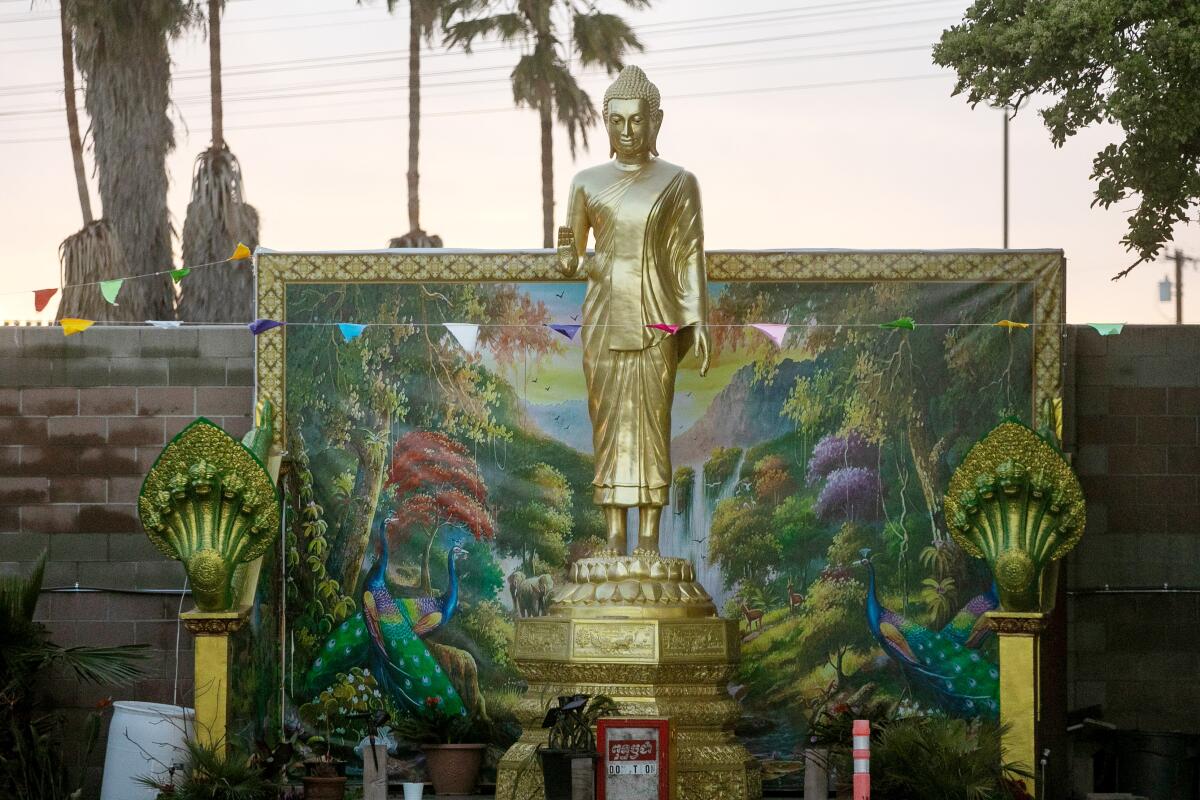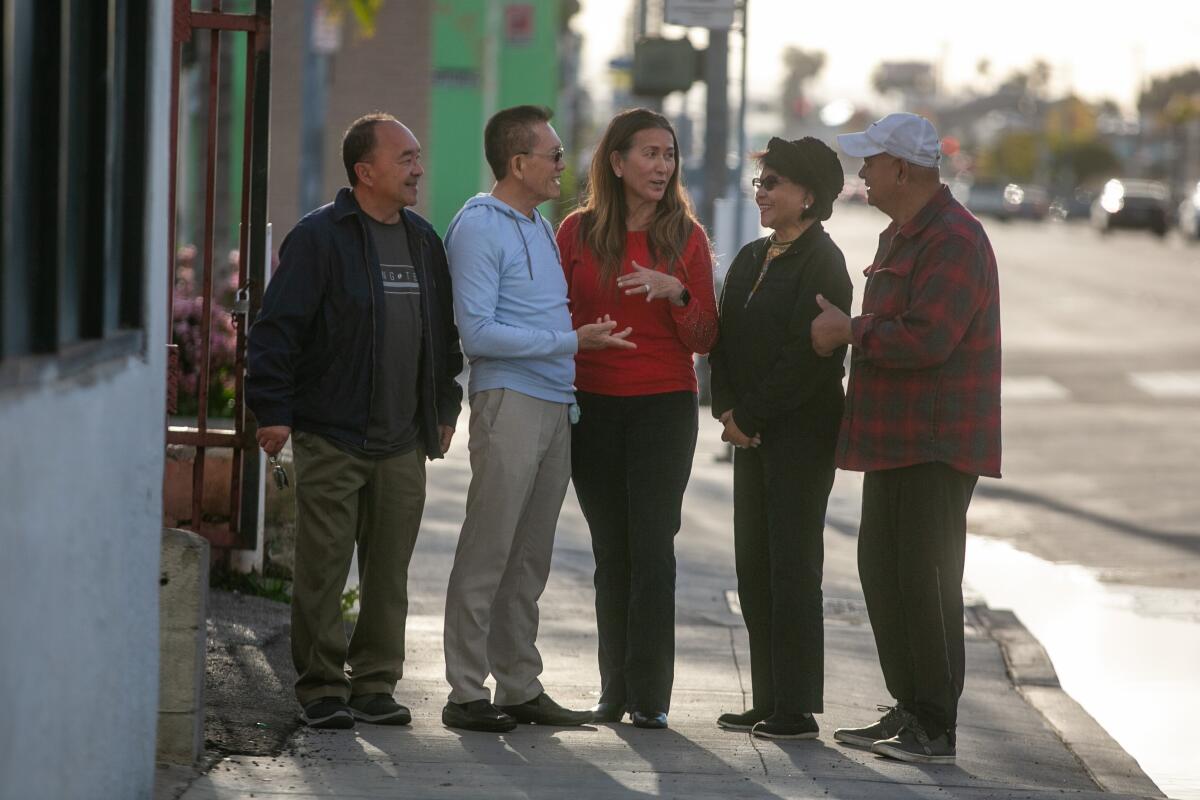Long Beach’s new year festival: Some Cambodian Americans aren’t happy with the name Sankranta

- Share via
At Long Beach’s first Sankranta festival to celebrate the Cambodian new year, people knelt and prayed at a mound of sand called a stupa, decorated with bright yellow flowers to honor ancestors.
They snacked on Cambodian barbecue pork chops with Belgian waffles and browsed booths with shirts featuring Angkor Wat, the famous temple.
A separate parade and celebration, which has been a fixture in the city for decades, followed the next day, April 2.
Sankranta means “beginning of a new year” in Khmer, Cambodia’s official language. But some Cambodian American elders have strongly objected to the new festival’s name.

At recent City Council meetings, they held signs reading “No Sangkranta in Long Beach” and “We always celebrate Cambodian New Year in Long Beach.”
They prefer an English name that incorporates “Cambodian” or “Khmer” to highlight their heritage and to acknowledge the other, decades-old celebration, which is community-led. Anything less, they say, makes them feel as if they are being erased.
If the Khmer language must be used, they prefer Chol Chnam Thmei, which translates to “entering the new year” and encompasses all three days of the holiday, not just the first day.
They also believe that Sankranta is too similar to Songkran, a term for the new year used in Thailand. Although Cambodia and Thailand generally get along, there have been occasional flashpoints, including Thailand’s support of the Khmer Rouge regime.
In Cambodia, the Angkor Sankranta festival is associated with the prime minister’s son, Gen. Hun Manet, whose 2016 visit to Long Beach sparked protests because of his father’s past as a Khmer Rouge commander and role in a government repeatedly accused of election fraud and human rights abuses.

Sovachana Pou, a 66-year-old senior research fellow studying Southeast Asia at the Cambodian Institute for Cooperation and Peace, pointed to the community’s history as refugees.
“Whatever we are left with is our identity and our culture,” said Pou, who came to the U.S. from Cambodia in 1975. “We are trying to protect that.”
But for Suely Saro, the first Cambodian American council member in a city with the largest Cambodian population in the U.S., the new festival’s name is an effort to embrace other Asian communities.
It’s also a way to go “back to our roots,” said Saro, 42, highlighting Sankranta’s origins in Cambodia’s state religion of Buddhism.
Her council office organized the festival and contributed about $50,000.
“Sankranta is a celebration that is being recognized in Cambodia, in Laos, in Thailand, in Myanmar, in Sri Lanka and some parts of India,” Saro told a crowd at the festival, which included Hmong and Filipino dancers. “This is about inclusivity.”

Nearly five decades ago, Cambodian refugees who fled the murderous Khmer Rouge regime began settling in Long Beach. The community eventually grew to about 20,000 Cambodian American residents.
In 2007, the city designated a mile-long stretch of Anaheim Street as Cambodia Town.
For the record:
12:07 p.m. April 17, 2023A previous version of this story said that Cambodian Americans were key in pushing Long Beach to elect council members by district, rather than at-large. Cambodian Americans pushed for the creation of an independent redistricting commission — council members were already elected by district.
Cambodian Americans were key in pushing the city to form an independent redistricting commission, which ultimately unified all of Cambodia Town in one district.
In Cambodia Town, some of Saro’s constituents feel betrayed by her determination to use the Sankranta name.
Inside New Pho restaurant, community activists Tippana Tith and Charles Song shared Chinese crullers called cha kway.
Tith, 67, pointed to a flier from Saro’s campaign, which pictured her standing next to Song.
“We were her friend,” said Tith, who arrived in Long Beach in 1978. “We were her helper to get her elected.”
Tith was a founder of the long-running Cambodian New Year community celebration. Across more than four decades, organizers have sometimes had to fight for city support, he said.
One year, the celebration had to move from its traditional home of El Dorado East Regional Park to Lancaster, about 90 miles north, because organizers couldn’t afford the $40,000 cost of police overtime.
The Cambodian New Year starts April 13 or 14, marking the end of the harvest season and the sun entering Aries. It is based on an ancient horoscope with roots in the solar calendar.
Culture: After a generation of obscurity, it declares an unofficial Little Phnom Penh in Long Beach.
Despite opposition from Tith, Song and other Cambodian elders, the Long Beach City Council twice voted unanimously, in February and March, to support Saro’s proposal for the Sankranta festival.
At the March council meeting, some praised Saro, saying she has educated the community about the word Sankranta and that it is used in Cambodia at different temples and pagodas.
“I keep telling my children, to complete the full meaning of the Khmer New Year, we should add Sankranta,” Linda Kim told the council through a Khmer interpreter.
But some at the council meeting said they did not see the need for a separate festival.
“Why would she come up with another event of the same thing just the day before, using a different name — just to twist it and make it hers?” asked Sophie Wherritt, a 57-year-old retired corporate executive from Mission Viejo who came from Cambodia in 1980.
Sophea Seng, an assistant professor of Asian American studies at Cal State Long Beach, said the controversy speaks to some elders’ anxiety about being ignored while the neighborhood changes.
Many Cambodian refugees came to the U.S. without any financial assets, said Sophal Ear, senior associate dean of student success and an associate professor at the Thunderbird School of Global Management at Arizona State University, who has long studied the community.
That, he said, has made some feel on unequal footing with other Southeast Asian American communities.
For them, a new festival with an unfamiliar name similar to that used in another country might feel threatening.
“People genuinely feel that what is happening is the encroachment to what they consider to be their city,” he said.
Amid concerns about gentrification and struggling businesses, Cambodia Town restaurants like Phnom Penh Noodle Shack have gained widespread recognition.
The park at the center of the neighborhood will undergo a multimillion-dollar renovation, and planning is underway for a Cambodian American Cultural Center.
“Those community leaders who disagree with the (Sankranta) term know I’ve worked very hard to ensure that we prioritized these major, long-lasting investments,” Saro said.
Saro, who was born in a refugee camp in Thailand, acknowledges the need to preserve the community’s history. She said she worked with organizations such as United Cambodian Community to organize the festival.
Noting that her aunt is Laotian, Saro said that connecting diverse communities will give them collective power.
“I represent the Asian American community in Long Beach,” she said. “I feel that’s part of my responsibility, to represent not just the Cambodian, Southeast Asian but the broader Asian community as well as Pacific Islanders too.”
Soup Pha, a 36-year-old musician, performed at the Sankranta festival, debuting an original Khmer single, “Kom Los Srok Chhngay,” or “The Boy from a Faraway Country,” about an L.A. guy falling in a love with a country girl in Cambodia.
Wearing a traditional Cambodian-Thai jacket and breeches in shiny cream-colored silk, he danced and crooned as a crowd of hundreds milled around. He also debuted two other songs, one in Thai and one in Thai and Khmer.
Pha, whose father is Cambodian and whose mother has Thai, Chinese, Cambodian and Vietnamese roots, grew up in Long Beach and has sung about his family’s experience during the genocide in Cambodia.
“We want to make sure they still feel welcome too,” Pha said of the city’s Thais, Laotians and others. “Nothing is being forgotten. … Long Beach has Cambodia Town on every corner … Everyone knows Cambodia Town.”
More to Read
Sign up for Essential California
The most important California stories and recommendations in your inbox every morning.
You may occasionally receive promotional content from the Los Angeles Times.















